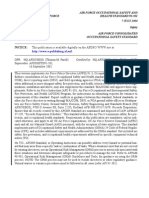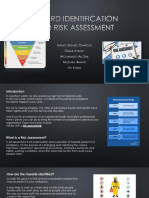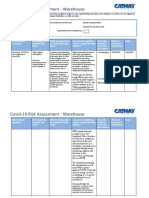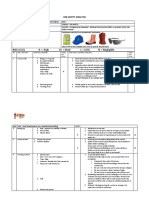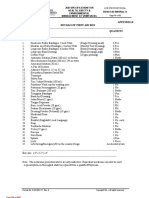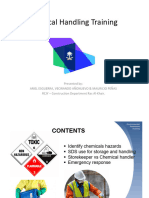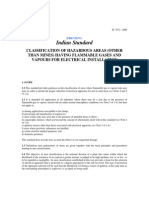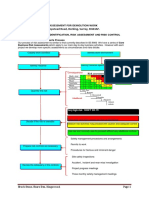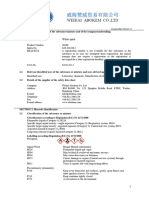Hira
Hira
Uploaded by
rajmohapatraCopyright:
Available Formats
Hira
Hira
Uploaded by
rajmohapatraOriginal Description:
Copyright
Available Formats
Share this document
Did you find this document useful?
Is this content inappropriate?
Copyright:
Available Formats
Hira
Hira
Uploaded by
rajmohapatraCopyright:
Available Formats
th
Proceeding 8 International Seminar on Industrial Engineering and Management
ISSN : 1978-774X
THE ANALYSIS OF HEALTH AND SAFETY ASPECTS BY USING HAZARD
IDENTIFICATION AND RISK ASSESSMENT (HIRA) METHOD
Dian Palupi Restuputri1, Mochammad Fakhri2
Department of Industrial Engineering, University of Muhammadiyah Malang, Indonesia
restuputri@umm.ac.id1, restuputri@yahoo.com1
ABSTRACT
Company X is a producer of fodder machine's spare parts, along with its reparation. In the
production activities carried out, there are some direct actions relating to engines and
presenting hazard to workers. On 2013, 34 occupational accidents cases were suffered by
workers in the production area. Begins with the identification of the point - the point which
could lead to accidents, this study aims to determine the causes of accidents so that control
measures can be carried out and the proposed improvements. Started with identification of
points leading to accidents, this research was aimed to find out the causes in order to carry
out controlling action, as well as propose improvements. The identification process was
conducted by using Hazard Identification and Risk Assessment (HIRA) method. Based on
the hazard identification process, 19 types of danger sources are obtained, whereas the
most greatest risk is sandwiched-workers in hydraulic cutting machines and eye irritation
due to lathe grams spark, each worth 7%. Based on risk level, there are 9 types of
moderate risk hazard and 10 types of high risk hazard.
Keywords: Occupational Health and Safety, HIRA, Risk Analysis
1. INTRODUCTION research is carried out by using a method
which is a technique to identify potential
Human resources has an important role hazard (hazard) of occupational accidents,
for the success of organization or company, namely HIRA (Hazard Idenfication Risk
because human life is sort of asset which Assessment) method. This is a structured
needs to be maintained. It means that and systematic checking process of existed
company's human resources is able to planning and process or operation to identify
provide optimum contribution in achieving and evaluate problems in order to reduce
organization's objectives. One main thing accidents (Gokul and Shivasankaran, 2014).
should be concerned by company is Only a few methods use the principles of
Occupational Safety and Health (K3) risk assessment (cause consequence-
system. In Indonesia, many Occupational release-dispersion-effect) as the basis for
Health and Safety (K3) problems are still their structure (Metrik, EHS) or apply some
frequently occured. A data from PT. Social kind of model (e.g., for dispersion) to
Security (Persero) show that there were an estimate a value related to the possible
average of 414 occupational accidents damage (HIRA). Such methods are
cases per day during 2007 to 2011, preferable. (Koller et al 2001).
(Accessed from Occupational Accidents Here are some data of accident cases
Data of PT.Jamsostek (Persero)). CV. undergone by workers in production area
Konstalindo is a producer of fodder during 2013:
machine's spare parts, along with its
reparation. During production process, In the Tabel 1 List of Accident Occurred in 2013
production activities carried out, there are No Type of Accident Amount
some direct actions relating to engines and 1 Strucked down or sandwiched 2 people
presenting hazard to workers by raw materials
As many accidents cases occured, in 2 Electrocuted 3 people
accordance with Table 1, CV. Konstalindo 3 Stumbled by work materials 2 people
must control potential accidents hazards in 4 Slipped by slippery floor 2 people
workplace environment. Therefore, this 5 Hand scratched by machine 4 people
The Analysis Of Health And Safety Aspects
(Dian Palupi Restuputri) ER-37
th
Proceeding 8 International Seminar on Industrial Engineering and Management
ISSN : 1978-774X
Tabel 1 List of Accident Occurred in 2013 Risk analysis requires knowledge of both
No Type of Accident Amount the probability (frequency or likelihood of
6 Hand blistered / burned 2 people occurrence), and the consequence (impact,
7 Sandwiched by Hydraulic 1 people damage, or injury level) of the upset event.
Cutting Machine Risk assessment is the process used to
8 Hand scratched by raw 4 people determine how to manage the risk identified
materials by the analysis (Legget, 2012)
9 Hand exposed by hammer 3 people
According Gokul and Shivasankaran.
10 Hearing loss 1 people
(2014), as quoted from OHSAS 18001, the
11 Respiratory and eye disorders 2 people
best way to reduce danger is to get rid of
12 Injured by splash of gram flake 5 people
13 Shoulder injury 3 people everything which have any potential hazard
Total 34 people leading to work accident. The following is
HIRA identification process by using UNSW
2. THEORETICAL BACKGROUND Health and Safety (2008 ):
Hazard is a situation that allows or 1. Hazard Identification
potential for the occurrence of events such In this stage, a hazard Identification process
as injury, illness, death, damage or inability was conducted to find out the potetntial
to perform operational functions have been danger points which leads to workplace
assigned (Tarwaka, 2008) accidents, from the beginning until the end
Hazard is a state (energy, action, of production process, in order to see all the
condition) which allow or cause injury, irregularities occurred in the company
illness, death or damage to property
including the keruskan environment, 2. Risk Assessment
including in the definition of this danger is Risk analysis stage was done by defining
the environmental aspect (Aminuddin, 2011) the main sources and roots of accidents or
HIRA (Hazard Identification Risk process interruption.
Assessment) method is the initial stage of The measures of risk analysis are:
risk management. HIRA (Hazard 1. Estimation of risk criterion
Identification Risk Assessment) method is a 2. Determination of seriousness / severity
structured and systematic checking process level
of existed planning and process or operation 3. Risk Cluster Matrix
to identify and evaluate problems in order to 4. Diagram of Risk Percentage
reduce accidents (Gokul and
Shivasankaran, 2014). 3. Risk Control
The concept of Idenfication Hazard Risk In this stage, a risk control analysis was
Assessment (HIRA) also used by Kumar and conducted to find points which cause
Kumar (2014) in order to identify and control occupational hazard in CV. Konstalindo.
hazards that occur in the foundry company This stage was aimed to transform
in India, as well as the Department of Public uncertainties into benefits for the company,
Safety and Correctional Services Ontario by preventing the occurrence of threats.
Provincial HIRA use the concept in 2012 to The last stage of controlling and
prevent and reduce the hazards that occur in improvement is classifying each hazard by
the Province of Ontario. degree of danger risk, including:
Hazard and operability analysis 1. Extreme Risk Hazard
(HAZOP, Imperial Chemical Industries, 2. High Risk Hazard
1974), fault tree analysis (Parmar and Lees, 3. Moderate Risk Hazard
1987) and failure mode and effect analysis 4. Low Risk Hazard
(Lees, 1996) are examples of qualitative
techniques. Khan and Abbasi (1998) 3. RESEARCH METHOD
introduced the hazard identification and
ranking (HIRA) methodology as a systematic The research method used in this study
tool to be automated in a software in order to is descriptive research. It describes amount
reduce expert time of data which is analysed and compared
The Analysis Of Health And Safety Aspects
ER-38 (Dian Palupi Restuputri)
th
Proceeding 8 International Seminar on Industrial Engineering and Management
ISSN : 1978-774X
based on the ongoing fact, while the further 2. Vertical scrap/smoothing, it is conducted
action is trying to giving solution in form of on the long section of cut steel plate.
improvement recommendations in order to 3. Horizontal scrap/smoothing, it is
obtain better results. This study focuses on conducted on the long section of cut
the occupational health and safety steel plate.
management systems by using Hazard 4. Cutting, any 33cm x 55cm steel sheet
Identification and Risk Assessment (HIRA) were cut back to 15cm x 50cm.
method. 5. Lathing, the lathing process or re-
smoothing process on steel plates' long
The identification processes by using HIRA and wide section were conducted.
are: 6. Manual Pressing, performing the bent
1. Hazard Identification plate alignment, to make it precious, by
Identifying any hazards in particular hammering it manually.
production area, from the beginning to the 7. Perforation, it was carried out using a
end of the process, by controlling any hydraulic perforation machine.
deviations 8. Carbonizing process, a process of
2. Risk Assessment coating and increasing steel content by
Conducting a risk analysis of the using specific formulations, heated in
identified hazard to see which one has 1000 Celcius temperature degree for
the greatest risk. about 12 hours.
3. Risk Controls 9. Cooling, the cooling or temperature
Ranking the hazards based in risk neutralization process is carried out by
analysis results and determining which using water.
one should be fixed soon. 10. Pressing, It was conducted by hydraulic
Analysis phase is conducted by defining press machine so carbonated plates
the main sources and roots of accidents have more value.
or process interruption. The steps are: 11. Inspection, a process of inspection or
a. Conducting an analysis of the main checking armored plates' quality was
sources and roots of accidents or also conducted.
process interruption. 12. Packaging, a process where the
b. Performing risk assessment analysis armored plates were packaged into
and using HAZOP worksheet to boxes.
obtain appropriate improvement
recommendations to be applied in After discovering CV. Konstalindo's
the research object. production process, a Hazard dan Risk
4. Risk Handling (Improvement Action, identification was conducted as following in
Procurement Recommendation of PPE, table 2.
Improvement Proposal) Before conducting ranking, it is necessary to
In this stage, an analysis of improvement formulate criterion of seriousness or risk
design was conducted to discover which ranking degree by considering risk criterion
one should be applied at the occupational existing in Company X as follows:
hazards points in company's production 1. Likelihood (L) is the possibility of
area in order to minimize accidents. accidents occurrence (Table 3).
2. Severity or Consequences (C) is the
4. RESULT AND DISCUSSION seriousness of the injury and working
days loss (Table 4).
Prior to identify hazard potential in CV.
Konstalindo's production process, the
manufacturing process should be known
first. The process flows are:
1. Cutting, any A36 type steel plate sheets,
with 2m x 1.5m large and 6mm in
thickness, were cut into 33cm x 55cm.
The Analysis Of Health And Safety Aspects
(Dian Palupi Restuputri) ER-39
th
Proceeding 8 International Seminar on Industrial Engineering and Management
ISSN : 1978-774X
Table 2. Hazard and Risk Identification Table 4. Consequences Criterion
(UNSW Health and Safety, 2008)
Rating assessment of consequences and
likelihood is presented in table 5 below:
Table 5. Rating of Consequence and Rating
Likelihood
Table 3. Likelihood Criterion
(UNSW Health and Safety, 2008) Risk Assessment is conducting by using
Risk Matrix as presented in Figure 1.
The Analysis Of Health And Safety Aspects
ER-40 (Dian Palupi Restuputri)
th
Proceeding 8 International Seminar on Industrial Engineering and Management
ISSN : 1978-774X
Table 7. Risk Score Calculation
Figure 1. Risk Assessment Matrix
(UNSW Health and Safety, 2008)
Risk of accidents discovered in CV.
Konstalindo’s production process are then
classified into the matrix above. The
classification can be seen in the following
table:
Table 6. Matrix Ranking Rating
Based on the data presented in Table 7, the
percentage of each risk can be seen in
Figure 3 below:
Based on the data in table matrix, risk
scores and priorities can be calculated in
order to take remedial action, whose results Figure 2. Risk Procentage
can be seen in Table 7 below:
After discovering the percentage of each
risk, the next action is calculating priority of
each risk in accordance with priority
classification presented in table below.
The Analysis Of Health And Safety Aspects
(Dian Palupi Restuputri) ER-41
th
Proceeding 8 International Seminar on Industrial Engineering and Management
ISSN : 1978-774X
Table 8. Priority Index of Improvement After identifying each risk above, some
Action hazard prevention actions could be made,
Hazard
Action
based on their risk level, namely:
Level 1. Moderate Risk Hazard
1-5 No need to act immediately, but It includes Limb Electrocution, Limb
keep inspected Sandwiched in Steel Plate, Body
6-10 Perform reparation in the next one Strucked Down by Roller Crumble, Hand
year
Scratched by Lathe, Hand Grazed by
11-15 Take action in the next three
months.
Horizontal Scrap Machine, Suffering
16-20 Take reparation action within one
Hearing Disorders, Respiratory Disorders,
month ahead. Eye Disorders, and Shoulder Burdened
21-25 Take action immediately/possible by Steel Plate.
use restriction 2. High Risk Hazard
Some hazards which are considered high
The results of improvement actions priority risk are Eye Iritation, Stumbled by
for each risk above can be seen in Table 9. Machine's Feet, Slipped by Slippery
Once you know which risks are the most Floor, Hands Scratched by Scrap Vertikal
prioritized, the next step is to carry out 19 Machine, Hand Burned, Hand Grazed by
risk evaluation measures, where every event Steel Plate, Hand Scratched by Roller
pose a potential hazard. Crumble, Hand Exposed by Hammer,
Shoulder burdened by Roller Crumble,
Table 9. Improvement Actions Priority and Sandwiched by Hydraulic Cutting
Machine.
This point of improvement proposal using
HAZOP Worksheet, which is a data
discussion analysis describing more details
about the causes, in order to find out the
best action to overcome the problems.
Analysis of Improvements Proposal
1. Good working conditions, which are both
comfortable and support workers to do
their activities properly, including
everything in workers' environment that
may affect employess performance, as
well as occupational safety. Therefore,
such working conditions, consist of
physical condition, psychological
condition, and temporary condition of
work environment, must be taken
appropriately to ensure that workers feel
comfortable at work for the sake of
improving labor productivity.
2. Working procedure is a series of
sequential working method, which is step
by step and clearly shows the path or flow
to be taken, where the work came from,
where to pass, and when or where is the
completion It could be supporting
equipment, in terms of completion of
works/tasks in certain field. Work
procedures should be well-arranged in
order to be carried out consistently,
thereby improving work procedures can
The Analysis Of Health And Safety Aspects
ER-42 (Dian Palupi Restuputri)
th
Proceeding 8 International Seminar on Industrial Engineering and Management
ISSN : 1978-774X
create a interrelated sequence or work the previous chapters, conclusions are made
system to facilitate job management. as follows:
3. A training on the importance of 1) The potential occupational accidents risks
Occupational Safety is a designed occurred in CV. Konstalindo's production
program giving provision to employees area came from some sources, which has
appointed by company to be able to apply been classified into 13, include: Strucked
the K3 in their workplace. The presence Down and Sandwiched by Raw Materials,
of K3 training is expected to give the Electrocuted, Tripped by Materials,
understanding about things needed in K3 Slipped by slippery floor, Hands are
implementation in the workplace. Scratched by Machine, Hand Blisters /
4. PPE Visual Display or poster, and the Burns, Sandwiched by Hydraulic Cutting
illustration of Occupational Health and Machine, Hand Scratched by Raw
Safety (K3) importance is a means to Materials, Hand Exposed by Hammers,
civilize safety campaign. Through the Hearing Loss, Respiratory dan Eye
posters and displays, it is expected that Disoreders, Injured by Gram Flakes'
public awareness of safe, comfortable Sparks, and Shoulder Injury. Among
and healthy work culture will be arised.. those, injury by gram flake's splash of
Do not forget to make it easy to read and lathe operation have the highest amount.
do by workers. 2) The Moderate Risk Hazard posed in CV
5. Machine maintenance is to keep and Konstalindo's production area are Eye
raise the its efficiency, optimize the power Iritation, Stumbled by Machine's Feet,
to the desired result, and prevent sudden Slipped by Slippery Floor, Hand
severe damage. Scratched by Vertical Scrap Machine,
6. The significance of engine saving is to Hand Burned, Hands are Grazed by Steel
provide a cover on lathe to menghindari Plate, Hand Scratched by Roller Crumble,
steer clear of workers from gram flake Hand Exposed by Hammer, Shoulder
spark during smoothing process. burdened by Roller Crumble, and
7. Providing non-conventional items- Sandwiched by Hydraulic Cutting
remover tools, such as manual hand Machine. The highest risk score is 10, fall
truks. on Eye Irritation which is caused by
8. Personal Protective Equipment (PPE) is grame flakes' splash during lathe
the compulsory attribute must be used operation system.
during working, in accordance to work 3) After identifying the potential hazards, the
hazards and risks level, to keep the overall recommendations are given to the
workers's safety, as well as people company, they are:
aroung him. 1. Improving unsafe working conditions
9. Periodic inspections is a means to 2. Arranging good working procedures
monitor health and safety aspects in 3. Conducting K3 training to workers
CV.Konstalindo, periodic inspections 4. Making a visual display/poster
carried out in accordance with the danger encouraging to always use APD
level of particular hazard. If the source of 5. Making sewer of stagnant water and
hazard has a moderate (S) risk level, then oil
the inspection could be 1 time in 3 6. Machine maintenance
months, whereas for high-risk level (T), 1 7. Preserving engines which causes
time per month inspection should be grams spark
performed. The periodic inspection is 8. Providing the non-conventional
carried out according to the level of risk of removal tools, namely: Manual Hand
each hazard occurred. Truck
9. Providing APD, namely:
5. CONCLUSIONS Safety Helmet
Safety Googgles
Based on the expected goals which fit the Safety Gloves
data and its processing results presented in Masks
Safety Shoes
The Analysis Of Health And Safety Aspects
(Dian Palupi Restuputri) ER-43
th
Proceeding 8 International Seminar on Industrial Engineering and Management
ISSN : 1978-774X
Safety Vest Clothes (h) Legget, David J. 2012. Lab-HIRA:
Ear Safety Hazard identification and risk analysis for
10. Conducting periodic inspections the chemical research laboratory. Part 2.
Risk analysis oflaboratory operations.
6. REFERENCES Journal of Chemical Health & Safety.
September-October, Pgs : 25-36.
(a) Amminudin, Arif. 2011. Kajian (i) Parmar, J.C., Lees, F.P. 1987. The
Penerapan Manajemen Resiko propagation of faults in process plants—
Keselamatan dan Kesehatan Kerja hazard identification. Reliab. Eng. Syst.
Lingkungan (K3L) Pada Proses Blasting Saf. 17, 277–302.
di Area Pertambangan Batubara PT. (j) Tarwaka. 2008 .Keselamatan dan
Cipta Kridatama : Tugas Akhir. Kesehatan Kerja. Surakarta : Harapan
Surakarta : Universitas Sebelas Maret Press.
Surakarta (k) http://helmidadang.wordpress.com/2012/
(b) Gokul, Raj S dan Shivasankaran, N. 12/30/hira-hazard-identification-and-risk-
2014. Hazard Identification And Risk assessmentandsample-of-hira/. Hazard
Assessment In Deinking Plant. Identification and Risk Assessment.
International Journal Of Research In (Access date : June 28 2014)
Aeronautical And Mechanical (l) http://www.ohs.unsw.edu.au/ohsriskman
Engineering. Vol.2 Issue.3, Pgs: 202-208 agement. Risk Assessment. (Access
(c) Imperial Chemical Industries-Mond date : July 9 2014)
Division. 1985. The Mond Index, second (m) http://www.jamsostek.co.id/content/news
ed. ICI, Explosion Hazards Section, .php?id=1031. Data Kecelakaan Kerja
Technical Department, Norwich. PT.Jamsostek. (Access date : August 24
(d) Khan, F.I., Abbasi, S.A. 1998. 2014)
Multivariate hazard identification and
ranking system. Process Saf. Prog. 17, AUTHOR BIOGRAPHIES
157–170.
(e) Koller, G., Fishcer, U., Hungerbuhler, K., Dian Palupi Restuputri is a lecturer in
2001. Comparison of Methods Suitable Department of Industrial Engineering,
For Assessing The Hazard Potential of Faculty of Industrial Technology, Universitas
Chemical Processes During Early Muhammadiyah Malang. She received her
Design Phases. Trans IchemE, Vol 79 Master of Industrial Engineering from Institut
May, Part B. Technology Bandung in 2013. Her research
(f) Kumar, M.Saravana dan Kumar, Dr. P. interests are in the area of ergonomic. She
Senthil. 2014. Hazard Identification and is a secretary of departement of industrial
Risk Assessment in Foundry. IOSR engineering, Universitas Muhammadiyah
Journal of Mechanical and Civil Malang. Her email address is
Engineering (IOSR-JMCE). <restuputri@yahoo.com,
(g) Lees, F.P. 1996. Loss Prevention in restuputri@umm.ac.id>
Process Industries, second ed.
Butterworth-Heinemann, Oxford.
The Analysis Of Health And Safety Aspects
ER-44 (Dian Palupi Restuputri)
You might also like
- UV30491 Monitor and Maintain HS Zoe Reynolds Outcome 2Document4 pagesUV30491 Monitor and Maintain HS Zoe Reynolds Outcome 2ellyusana100% (1)
- Afoshstd91 501Document381 pagesAfoshstd91 501Thomas M RiddleNo ratings yet
- Wilmar SPCC Risk Assessment Checklist - V7 - EN-12023Document786 pagesWilmar SPCC Risk Assessment Checklist - V7 - EN-12023heikal hajazie50% (2)
- Olifantsvlei: General Site Operations - Flame CuttingDocument4 pagesOlifantsvlei: General Site Operations - Flame CuttinggrantNo ratings yet
- Risk Assessment Form - JEOL 7100FLV SEM - Vysakh - MRes Mol MicroDocument2 pagesRisk Assessment Form - JEOL 7100FLV SEM - Vysakh - MRes Mol MicroVysakh PRNo ratings yet
- The Handbook of Safety Engineering: Principles and ApplicationsFrom EverandThe Handbook of Safety Engineering: Principles and ApplicationsRating: 4 out of 5 stars4/5 (1)
- AHSE01 HSE Manual Issue1 Rev 01Document26 pagesAHSE01 HSE Manual Issue1 Rev 01Ali Zafar100% (1)
- Welcome To Awareness Program On Hazard Identification, Risk Assessment & Determining ControlDocument26 pagesWelcome To Awareness Program On Hazard Identification, Risk Assessment & Determining ControlshishunalNo ratings yet
- HIRA FormatDocument2 pagesHIRA FormatSAYED ROMARIONo ratings yet
- Storage of Chemical - Risk AssessmentsDocument1 pageStorage of Chemical - Risk AssessmentsMohammed Amer PashaNo ratings yet
- Introduction To Ohs Management System Standards: Presenter: Zaikhasra Zainuddin 17 JULY 2009Document40 pagesIntroduction To Ohs Management System Standards: Presenter: Zaikhasra Zainuddin 17 JULY 2009Chandral VaradanNo ratings yet
- Rotek Valves Risk Assessment - Process: If You Have Any Questions, Please Contact The ManagerDocument3 pagesRotek Valves Risk Assessment - Process: If You Have Any Questions, Please Contact The ManagerPieter BezuidenhoutNo ratings yet
- BA SetDocument39 pagesBA SetKrishna PrasadNo ratings yet
- Hazard and Risk RegistersDocument18 pagesHazard and Risk RegistersWole OyefisayoNo ratings yet
- FiveSteps PDFDocument1 pageFiveSteps PDFMohamed FouadNo ratings yet
- Environment Agency EPR Compliance Assessment Report - May 2013Document4 pagesEnvironment Agency EPR Compliance Assessment Report - May 2013ServosteelNo ratings yet
- Risk Assessment 2Document2 pagesRisk Assessment 2Reece_MC100% (1)
- Risk Assessment Guidelines - 9cb0Document11 pagesRisk Assessment Guidelines - 9cb0andaminiNo ratings yet
- Generic Risk Assessment Form: (To Be Used For Routine Tasks and For Reference When Developing Project Specific RDocument8 pagesGeneric Risk Assessment Form: (To Be Used For Routine Tasks and For Reference When Developing Project Specific Rghada gattouchNo ratings yet
- First Aid Cases RecordDocument1 pageFirst Aid Cases RecordFrancis Enriquez TanNo ratings yet
- Accident CausationDocument34 pagesAccident CausationMark CheneyNo ratings yet
- Inspection Trade UnionsDocument35 pagesInspection Trade UnionsVenky Chowdary VankayalapatiNo ratings yet
- TRA 58 Unloading and Rigging Up Test EquipmentDocument4 pagesTRA 58 Unloading and Rigging Up Test EquipmentPirlo PoloNo ratings yet
- Aspect-Impact/ Hira Registry: Ccbpi Davao Plant EnvironmentDocument4 pagesAspect-Impact/ Hira Registry: Ccbpi Davao Plant EnvironmentRafhael EspinosaNo ratings yet
- Lone Working Risk Assessment Form 2016Document4 pagesLone Working Risk Assessment Form 2016Riza FirmansyahNo ratings yet
- HSE Management System PresentationDocument16 pagesHSE Management System PresentationAshraf AboeleninNo ratings yet
- Enviornmental Risk Assessment GuideDocument84 pagesEnviornmental Risk Assessment GuideDonald GrospeNo ratings yet
- Document - SOP429 Reporting Accidents NearMisses Needlesticks and Blood ContactsDocument9 pagesDocument - SOP429 Reporting Accidents NearMisses Needlesticks and Blood ContactsEmhemed Amer TabibNo ratings yet
- Location Risk Assessment Form-Part A: Basic Information & Hazard ListDocument3 pagesLocation Risk Assessment Form-Part A: Basic Information & Hazard Listapi-330049796No ratings yet
- Risk Assessment TEMPLATEDocument2 pagesRisk Assessment TEMPLATElwillia16No ratings yet
- First Aid Risk Assessment Template Charts IncludedDocument2 pagesFirst Aid Risk Assessment Template Charts IncludedSharif Fayiz AbushaikhaNo ratings yet
- Kaiser HVA Tool and InstructionsDocument7 pagesKaiser HVA Tool and InstructionsevyNo ratings yet
- Free Fall Calculations: What Is Fall Clearance?Document6 pagesFree Fall Calculations: What Is Fall Clearance?usman4428No ratings yet
- Occupational Health Hazards and Their Control Measures in Construction WorkDocument9 pagesOccupational Health Hazards and Their Control Measures in Construction WorkSantanu Kumar SahuNo ratings yet
- Ppe ChecklistDocument1 pagePpe ChecklistIvan BaraćNo ratings yet
- PPM-FRM-GEN-079 Contractor Baseline Risk AssessmentDocument22 pagesPPM-FRM-GEN-079 Contractor Baseline Risk AssessmentbenitaNo ratings yet
- Ignition Temperature of Dust Layer of Wood Pellets - 2013Document5 pagesIgnition Temperature of Dust Layer of Wood Pellets - 2013martinNo ratings yet
- BSC 5 Star AuditDocument4 pagesBSC 5 Star AuditbesteNo ratings yet
- Environment PolicyDocument3 pagesEnvironment Policyanuj.nigamNo ratings yet
- Risk Assessment PolicyDocument5 pagesRisk Assessment PolicyEffiong EmmanuelNo ratings yet
- Health & Safety: Chemical Risk Assessment FormDocument5 pagesHealth & Safety: Chemical Risk Assessment FormVerbi FernendiNo ratings yet
- Hazard Identification and Risk AssessmentDocument10 pagesHazard Identification and Risk Assessmentمحمد علي صايل مخلف D100% (1)
- Livestock Transportation Emergency Response Plan: With TheDocument4 pagesLivestock Transportation Emergency Response Plan: With Thek_klinoxNo ratings yet
- Manual Handling Risk AssessmentDocument21 pagesManual Handling Risk Assessmentremember100% (1)
- Hirarc 2023Document2 pagesHirarc 2023Ariff ZakariaNo ratings yet
- Covid-19 RiskAssessmentWarehouseDocument11 pagesCovid-19 RiskAssessmentWarehouseBalgo BalgobinNo ratings yet
- DBS Traffic Risk Assessment 2020-2021Document12 pagesDBS Traffic Risk Assessment 2020-2021MidhunRameshThuvasseryNo ratings yet
- Safety Observation RoundDocument6 pagesSafety Observation RoundBorislav VulicNo ratings yet
- Permit To Work at HeightsDocument2 pagesPermit To Work at HeightsVinod MNo ratings yet
- Accident/Incident Investigation - Supervisor Training: N.C. Department of Labor Mine and Quarry BureauDocument44 pagesAccident/Incident Investigation - Supervisor Training: N.C. Department of Labor Mine and Quarry BureauSHANZAY21111111No ratings yet
- JSA EmployeesDocument2 pagesJSA EmployeesburhanNo ratings yet
- Risk Assessment For Collaborative OperationDocument23 pagesRisk Assessment For Collaborative OperationTata OdoyNo ratings yet
- First Aid Box ContentDocument1 pageFirst Aid Box ContentwaytobhushanNo ratings yet
- Chemical Handling Training 2024Document25 pagesChemical Handling Training 2024abdallahmamdouh556No ratings yet
- Is 5572 - Hazardous ClassificationDocument2 pagesIs 5572 - Hazardous ClassificationMathavaraj DharmarajNo ratings yet
- Risk Assessment For Demolition Work 10 Hampstead Road, Dorking, Surrey, RH43AFDocument26 pagesRisk Assessment For Demolition Work 10 Hampstead Road, Dorking, Surrey, RH43AFmohammad Qutubuddin100% (1)
- HSE Inspection Checklist: 1 Safety PromotionDocument4 pagesHSE Inspection Checklist: 1 Safety PromotionRanjan PrNo ratings yet
- Safety CommitteesDocument13 pagesSafety CommitteesTry Lestari Kusuma PutriNo ratings yet
- TGC - Ehsp - 02. Ehs Objectives & TargetsDocument4 pagesTGC - Ehsp - 02. Ehs Objectives & TargetsAhmed El SayedNo ratings yet
- OCP For Handling of MaterialsDocument3 pagesOCP For Handling of MaterialsTigor GurningNo ratings yet
- Confined Space Entry - CCOHS-1Document12 pagesConfined Space Entry - CCOHS-1Mohamed hadjadj100% (1)
- Inspection GalleryDocument4 pagesInspection GalleryrajmohapatraNo ratings yet
- InterviewDocument9 pagesInterviewrajmohapatraNo ratings yet
- Quality in Classroom TransactionDocument3 pagesQuality in Classroom TransactionrajmohapatraNo ratings yet
- Chapter-2: Review of Related Literature 34-62Document29 pagesChapter-2: Review of Related Literature 34-62rajmohapatraNo ratings yet
- Chapter-2: Review of Related Literature 34-62Document29 pagesChapter-2: Review of Related Literature 34-62rajmohapatraNo ratings yet
- Safe Working On RoofsDocument24 pagesSafe Working On RoofsrajmohapatraNo ratings yet
- Factories (A) Bill, 2016Document8 pagesFactories (A) Bill, 2016rajmohapatraNo ratings yet
- 2666first Year B.tech Syllabus For Admission Batch 2016-17Document19 pages2666first Year B.tech Syllabus For Admission Batch 2016-17rajmohapatraNo ratings yet
- Due Diligence ChecklistDocument8 pagesDue Diligence ChecklistSithum RathnayakeNo ratings yet
- OCSPP-TestGuidelines MasterListDocument3 pagesOCSPP-TestGuidelines MasterListAhmed RashidNo ratings yet
- Organizational StructureDocument4 pagesOrganizational StructurepotatootamoooNo ratings yet
- Hazard DatabaseDocument1,193 pagesHazard Database1009 AMILINENI SUDHEER CHANDRANo ratings yet
- SDS For Flushing and Chemical Dosing.Document43 pagesSDS For Flushing and Chemical Dosing.farhanhussain852No ratings yet
- HIRA of Water Proofing Work.Document1 pageHIRA of Water Proofing Work.Gyanendra SrivastavaNo ratings yet
- Sasaran & Program Kerja K3L 2018 PT. HOCO (Rev.1)Document1 pageSasaran & Program Kerja K3L 2018 PT. HOCO (Rev.1)dennisjuntakNo ratings yet
- SSPC Ab 2Document4 pagesSSPC Ab 2Leo SchlossNo ratings yet
- Цагаан охь ХАЛМDocument6 pagesЦагаан охь ХАЛМKhulan Bat-erdeneNo ratings yet
- K12 TLE Curriculum Cookery Grade 7 - 10Document33 pagesK12 TLE Curriculum Cookery Grade 7 - 10Macqz Numlock Abas Kudto88% (8)
- Shams Ma'An Solar PV Power Plant Project (50MW) : 14 July 2014 Rev - 0Document13 pagesShams Ma'An Solar PV Power Plant Project (50MW) : 14 July 2014 Rev - 0MohamedNo ratings yet
- A New Conceptual Framework To Improve The Application of Occupational Health and Safety Management SystemsDocument17 pagesA New Conceptual Framework To Improve The Application of Occupational Health and Safety Management SystemsindahnurabidahNo ratings yet
- WorkSafe - Forklift ChecklistDocument2 pagesWorkSafe - Forklift Checklistjohnzepol100% (1)
- Basic Safety RulesDocument8 pagesBasic Safety RulesSarfraz RandhawaNo ratings yet
- Delivering Large Gas Cylinders: A Guide To Manual HandlingDocument18 pagesDelivering Large Gas Cylinders: A Guide To Manual HandlingJelena ĆukNo ratings yet
- Risk Management Manual / Site Safety PlanDocument5 pagesRisk Management Manual / Site Safety PlanmshahidshaukatNo ratings yet
- Antibacterial Hand Sanitiser Gel MSDS 0416Document6 pagesAntibacterial Hand Sanitiser Gel MSDS 0416Clara AcostaNo ratings yet
- Farhad CV NewDocument2 pagesFarhad CV Newsahibli96No ratings yet
- Titan Industries Limited: The Significance and The Application of The Operations StrategyDocument7 pagesTitan Industries Limited: The Significance and The Application of The Operations StrategySai Krishna Teja PamulaparthiNo ratings yet
- Eos Basic Clerical Works Level IDocument22 pagesEos Basic Clerical Works Level IeferemNo ratings yet
- Sulfuric Acid Safety Data SheetDocument9 pagesSulfuric Acid Safety Data SheetMukthiyar Basha ShaikNo ratings yet
- 3M Methyl Magnesium Chloride Solution in TetrahydrofuranDocument13 pages3M Methyl Magnesium Chloride Solution in Tetrahydrofuranjalal.mNo ratings yet
- 908 053 Butylated Hydroxytoluene Sds en Ghs Eu Pdf07012020040031 MSDSDocument9 pages908 053 Butylated Hydroxytoluene Sds en Ghs Eu Pdf07012020040031 MSDSBerkin DereliNo ratings yet
- Job Safety Analysis (JSA) - Painting DateDocument2 pagesJob Safety Analysis (JSA) - Painting DatenabeelNo ratings yet
- Emergency Response PlanDocument17 pagesEmergency Response PlanNasir KhanNo ratings yet
- Ergonomics PPT v-03!01!17Document54 pagesErgonomics PPT v-03!01!17Ajeet TiwariNo ratings yet
- Safety Data Sheet: Section 1. Identification: American Oil 22 Meridian Road Suite #6 Eatontown, NJ 07724Document6 pagesSafety Data Sheet: Section 1. Identification: American Oil 22 Meridian Road Suite #6 Eatontown, NJ 07724Rampal SinghNo ratings yet
- Event Emergency Management PlanDocument14 pagesEvent Emergency Management PlanPrincess Marie JuanNo ratings yet

